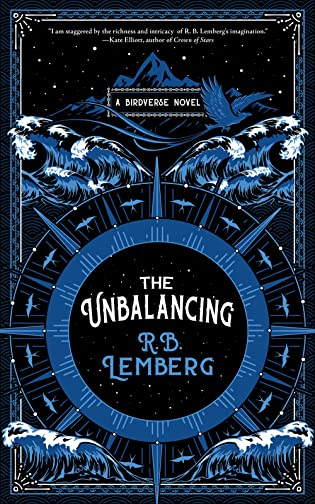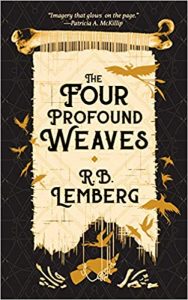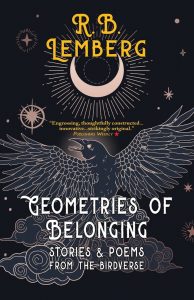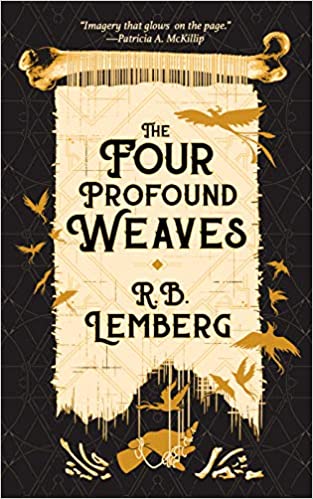 The Unbalancing by R.B. Lemberg
The Unbalancing by R.B. Lemberg Format: eARC
Source: supplied by publisher via NetGalley
Formats available: paperback, ebook
Genres: fantasy
Series: Birdverse
Pages: 241
Published by Tachyon Publications on September 20, 2022
Purchasing Info: Author's Website, Publisher's Website, Amazon, Barnes & Noble, Kobo, Bookshop.org, Better World Books
Goodreads
In this first full-length novel from the acclaimed Birdverse, new love blossoms between an impatient starkeeper and a reclusive poet as they try together to save their island home. Nebula, Locus, and Ignyte finalist R. B. Lemberg (The Four Profound Weaves) has crafted a gorgeous tale of the inevitable transformations of communities and their worlds. The Unbalancing is rooted in the mystical cosmology, neurodiversity, and queerness that infuses Lemberg’s lyrical prose, which has invited glowing comparisons to N. K. Jemisin, Patricia A. McKillip, and Ursula K. LeGuin.
Beneath the waters by the islands of Gelle-Geu, a star sleeps restlessly. The celebrated new starkeeper Ranra Kekeri, who is preoccupied by the increasing tremors, confronts the problems left behind by her predecessor.
Meanwhile, the poet Erígra Lilún, who merely wants to be left alone, is repeatedly asked by their ancestor Semberi to take over the starkeeping helm. Semberi insists upon telling Lilun mysterious tales of the deliverance of the stars by the goddess Bird.
When Ranra and Lilun meet, sparks begin to fly. An unforeseen configuration of their magical deepnames illuminates the trouble under the tides. For Ranra and Lilun, their story is just beginning; for the people of Gelle-Geu, it may well be too late to save their home
My Review:
My first introduction to the Birdverse was in The Four Profound Weaves. At the time I said it had the feel and sense of a myth in the making. The Unbalancing while telling a much different story, has the sense of a myth or legend being broken and remade, as the poet Erigra Lilun and the new starkeeper Ranra Kekeri are the ones left holding the very large and torn bag, so to speak, when the most heartbreaking chapter of this world’s origin story comes home, not to roost but to destroy, on their beloved home islands of Gelle-Geu.
The island confederation of Gelle-Gau has experienced regular earthquakes during its nearly 1,000 year history. Because one of the 12 stars that are part of this world’s creation myth – which is no myth in the Birdverse – rests uneasily in the ocean between the islands. Whenever the star gets restless there’s a tremor. In recent years those tremblers have been getting bigger, longer and more frequent.
There’s clearly something wrong, and it’s getting wrong-er all the time. The last starkeeper, the person whose duty it is to monitor the health of the submerged star, didn’t want to know. Or knew too much and wallowed in despair rather than searching for a solution.
Whatever is upsetting their star is going to result in an extinction level event for the islands. And it’s already too late for their beloved Gelle-Gau. The question before the new starkeeper and the shy, withdrawn poet who perhaps should have been starkeeper years ago is whether or not it is too late for their people.
And whether they will have time for a new beginning for themselves.
 Escape Rating A: I enjoyed my introduction to the Birdverse in The Four Profound Weaves and The Unbalancing was even better. Weaves was lovely but it was a bit of a quieter story in its way, while The Unbalancing is considerably more dramatic and dynamic by the very nature of the crisis it must contend with.
Escape Rating A: I enjoyed my introduction to the Birdverse in The Four Profound Weaves and The Unbalancing was even better. Weaves was lovely but it was a bit of a quieter story in its way, while The Unbalancing is considerably more dramatic and dynamic by the very nature of the crisis it must contend with.
The world, at least as far as the islands of Gelle-Gau are concerned, is ending. Attempting to hold back that literal tide pretty much guarantees a fast-paced story filled with high stakes, epic conflicts and nearly crushing lows and blows.
At the same time, it contains a beautiful story of opposites not only attracting but discovering that they belong together and need each other – not just to overcome the disaster that has crashed into their budding romance – but because they are both unbalanced, just as their star is, and they need each other to bring balance to their lives, their hearts, and ultimately their people.
This is also very much a coming of age or coming into maturity or simply a coming into self knowledge story. Ranra, the starkeeper has always known who and what she is in all her prickly, sometimes overbearing, always pushing forward self.
Lilún, very much on the other hand, is cripplingly shy, and so uncertain of their own nature or their place in the world to the point where they almost completely isolate themself. Lilún’s part of The Unbalancing is to finally figure out who they are in relation to their wider world. Because initially the only thing about themselves that they are certain of is that they are a gardener and tender of trees.
(Even their name evokes that identity. The name Lilún is reminiscent of “lulav”, one of the four plants that epitomize the Jewish harvest holiday Sukkot. Among the other plants is the etrog citron, which is abundant on Gelle-Gau to the point that it is used as the basis for a cool citrus drink similar to lemonade.)
 What gives this story its oomph – and lots of it – is the race to heal the star and save the islands. That the effort fails seems like it would be one hell of a downer – but it’s not. What makes the story rise in the end is the acknowledgement that the land, though beautiful, is not important. It’s the people that made the islands, and they’ll find a new place that they will make just as beautiful and fruitful, because they are bringing both the heart of Gelle-Gau and the heart of their beleaguered star along with them.
What gives this story its oomph – and lots of it – is the race to heal the star and save the islands. That the effort fails seems like it would be one hell of a downer – but it’s not. What makes the story rise in the end is the acknowledgement that the land, though beautiful, is not important. It’s the people that made the islands, and they’ll find a new place that they will make just as beautiful and fruitful, because they are bringing both the heart of Gelle-Gau and the heart of their beleaguered star along with them.
The more I read of the Birdverse, the more fascinated I become with this fantastic and fantastical place. The story in The Unbalancing is complete in and of itself, but it hints at depths that I found myself wishing I knew better. In other words, I loved it AND I wanted more. And I found it in Geometries of Belonging: Stories & Poems from the Birdverse, a collection of many of the foundational stories of this marvelous place. I’m looking forward to diving in and learning that MORE – and soon!

 The Four Profound Weaves by
The Four Profound Weaves by